Assessing the Effects of Dust on Solar Panel Performance: A Comprehensive Review and Future Directions †
Abstract
1. Introduction
2. Research Methodology
3. Results
3.1. Effects of Dust Accumulation on Solar Panel Performance
3.2. Technological Innovations and Solutions to Minimize Dust Impact
3.3. Predictive Approaches and Optimization of Solar Panel Maintenance
3.4. Synthesis of the Articles
4. Discussion
5. Conclusions
Author Contributions
Funding
Institutional Review Board Statement
Informed Consent Statement
Data Availability Statement
Conflicts of Interest
References
- Hussam, M.; Almukhtar, T.; Lie, T.; Al-Shohani, W.A. Comprehen-sive analysis of dust impact on photovoltaic module temperature: Experimental insights and mathematical modeling. Sol. Energy 2023, 265, 112125. [Google Scholar]
- Asbayou, A.; Ihlal, A.; Isknan, I.; Soussi, A.; Bouhouch, L. Structural and Physicochemical Properties of Dust and Their Effect on Solar Modules Efficiency in Agadir-Morocco. J. Renew. Mater. 2023, 11, 2249–2264. [Google Scholar] [CrossRef]
- International Energy Agency (IEA). World Electricity Generation in the Stated Policies Scenario, 2010–2035. Available online: https://www.iea.org/data-and-statistics/charts/world-electricity-generation-in-the-stated-policies-scenario-2010-2035 (accessed on 1 October 2025).
- MOmar, H.; Arif, A.; Usman, M.; Khan, S.S.; Larkin, S. Self-cleaning solution for solar panels. Afr. Res. J. 2023, 114, 58–66. [Google Scholar]
- Babalola, T.V.; Nafada, A.I.; Dala, H.A. An Assessment of the Impact of Accumulated Dust on Efficiency and Performance Output of Solar Photovoltaic Panels. Deleted J. 2024, 33, 87–94. [Google Scholar] [CrossRef]
- Fatima, K.; Minai, A.F.; Malik, H.; Márquez, F.P.G. Experimental analysis of dust composition impact on Photovoltaic panel Performance: A case study. Sol. Energy 2024, 267, 112206. [Google Scholar] [CrossRef]
- Ding, R. Application of Machine Learning in Optimizing Proton Exchange Mem-brane Fuel Cells: A Review. Energy AI 2022, 9, 100170. [Google Scholar] [CrossRef]
- Rusanescu, C.O.; Rusanescu, M.; Istrate, I.; Constantin, G.; Begea, M. The Effect of Dust Deposition on the Performance of Photovoltaic Panels. Energies 2023, 16, 6794. [Google Scholar] [CrossRef]
- Kazem, A.H. Dust impact on the performance of solar photovoltaic module: A new prospect. Energy Sources Part A Recover. Util. Environ. Eff. 2023, 45, 4087–4106. [Google Scholar] [CrossRef]
- Heo, M.G. Self-Powered Electrodynamic Dust Removal for Sustainable Solar Panels using Triboelectric Nanogenerators. Nano Energy 2024, 121, 109257. [Google Scholar] [CrossRef]
- Ahmad, T. Energetics Systems and artificial intelligence: Applications of industry 4.0. Energy Rep. 2022, 8, 334–361. [Google Scholar] [CrossRef]
- Haddad, Z.; Nahoui, A.; Salmi, M.; Aidjadj, M. Effect of dust on the operation of photovoltaic solar panels installed in the Hodna region-Experimental study. J. Renew. Energies 2023, 13, 75–82. [Google Scholar]
- Panat, S.; Varanasi, K. Electrostatic dust removal using adsorbed moisture-assisted charge induction for sustainable operation of solar panels. Sci. Adv. 2022, 8, eabm0078. [Google Scholar] [CrossRef] [PubMed]
- An IoT-Based Smart Monitoring Scheme for Solar PV Applications. 2025. Available online: https://www.researchgate.net/publication/350422875_An_IoT-Based_Smart_Monitoring_Scheme_for_Solar_PV_Applications (accessed on 1 June 2025).
- Antonello, F.; Segneri, D.; Reggestad, V. Surrogate model-based calibration of a flying Earth observation satellite. Adv. Space Res. 2024, 73, 1925–1935. [Google Scholar] [CrossRef]
- Ding, R. Self-Powered Autonomous Electrostatic Dust Removal for Solar Panels by an Electret Generator. Adv. Sci. 2024, 11, 2401689. [Google Scholar] [CrossRef] [PubMed]
- Ahmad, N.; Sattar, M.; Ghafoor, U.; Shah, U.H. Effect of Various Dusts and Humidity on the Performance of Renewable Energy Modules. Energies 2023, 16, 4857. [Google Scholar] [CrossRef]
- Abuzaid, H.; Awad, M.; Shamayleh, A. Impact of dust accumulation on photovoltaic panels: A review paper. Int. J. Sustain. Eng. 2022, 15, 264–285. [Google Scholar] [CrossRef]
- Vedulla, G.; Geetha, A.; Senthil, R. Review of Strategies to Mitigate Dust Deposition on Solar Photovoltaic Systems. Energies 2022, 16, 109. [Google Scholar] [CrossRef]
- Tripathi, A. Quantitative Analysis of Solar Photovoltaic Panel Performance with Size-Varied Dust Pollutants Deposition Using Different Machine Learning Approaches. Molecules 2022, 27, 7853. [Google Scholar] [CrossRef]
- Jaafar, H.A.S.S.; Maarof, R.T.; Salh, H.; Sahib, Y.; Azeez, H. Non-uniform dust distribution effect on photovoltaic panel performance. Renew. Energy Sustain. Dev. 2023, 9, 1–10. [Google Scholar] [CrossRef]
- Saini, R. Effects of dust on the performance of solar panels—A review update from 2015–2020. Energy Environ. 2023, 34, 958305. [Google Scholar] [CrossRef]
- Abraim, M. Comparative Study of Soiling Effect on CSP and PV Technologies under Semiarid Climate in Morocco. Sol. Energy Adv. 2022, 2, 100021. [Google Scholar] [CrossRef]
- Kamal, R.; Abdel-Salam, M.; Nayel, M. Performance characteristic of a PV module as influenced by dust accumulation: Theory versus experiment. J. Eng. Appl. Sci. 2023, 70, 2023. [Google Scholar] [CrossRef]
- Bodnár, I.; Matusz-Kalász, D.; Boros, R.R. Exploration of Solar Panel Damage and Service Life Reduction Using Condition Assessment, Dust Accumulation, and Material Testing. Sustainability 2023, 15, 9615. [Google Scholar] [CrossRef]
- Wu, S.-L.; Chen, H.-C.; Peng, K.-J. Quantification of Dust Accumulation on Solar Panels Using the Contact-Characteristics-Based Discrete Element Method. Energies 2023, 16, 2580. [Google Scholar] [CrossRef]
- Development of an Empirical Coefficient for the Short Circuit Current to Determine Soiling Effect on PV Performance. 2025. Available online: https://www.researchgate.net/publication/322065515_Development_of_an_Empirical_Coefficient_for_the_Short_Circuit_Current_to_Determine_Soiling_Effect_on_PV_Performance (accessed on 5 June 2025).
- Pradhan, A.; Panda, B.; Nanda, L.; Jena, C. Analysis of dust on the parameters of PV module and design of an effective solar dust cleaner. Int. J. Power Electron. Drive Syst. 2022, 13, 900. [Google Scholar] [CrossRef]
- Hossain, A.M.I.; Ali, V.B.; Benito, B.; Aïssa, F.B. Anti-Soiling Coatings for Enhancement of PV Panel Performance in Desert Environment: A Critical Review and Market Overview. Materials 2022, 15, 7139. [Google Scholar] [CrossRef]
- Tamoor, M. Investigation of dust pollutants and the impact of suspended particulate matter on the performance of photovoltaic systems. Front. Energy Res. 2022, 10, 2022. [Google Scholar] [CrossRef]
- Chaichan, M.T. Sand and Dust Storms’ Impact on the Efficiency of the Photovoltaic Mod-ules Installed in Baghdad: A Review Study with an Empirical Investigation. Energies 2023, 16, 3938. [Google Scholar] [CrossRef]
- Zhang, Z. Experimental investigation of a monitoring model for dust deposition on solar photovoltaic modules. Int. J. Green Energy 2023, 21, 625–639. [Google Scholar] [CrossRef]
- Raillani, B.; Ouali, H.A.L.; Amraqui, S.; Moussaoui, M.A.; Mezrhab, A. Techno-economic impact of optical soiling losses on solar tower and linear Fresnel reflector power plants: Experimental and numerical investigation. Int. J. Green Energy 2022, 19, 1665–1674. [Google Scholar] [CrossRef]
- Sarhan, E.M.; Salman, A.Z.; Jasim, K.K. An analytical study to reduce the effect of dust on the performance of solar panels using water system. J. Renew. Energy Res. 2022, 21, 85–101. [Google Scholar]
- Gebreil, A.; Matar, S.; An, H. Optimal Scheduling of PV Panel Cleaning and Policy Implications Considering Uncertain Dusty Weather Conditions in the Middle East. Systems 2024, 12, 418. [Google Scholar] [CrossRef]
- Guo, M. Advances in biorenewables-resource-waste systems and modelling. Carbon Capture Sci. Technol. 2023, 9, 100142. [Google Scholar] [CrossRef]
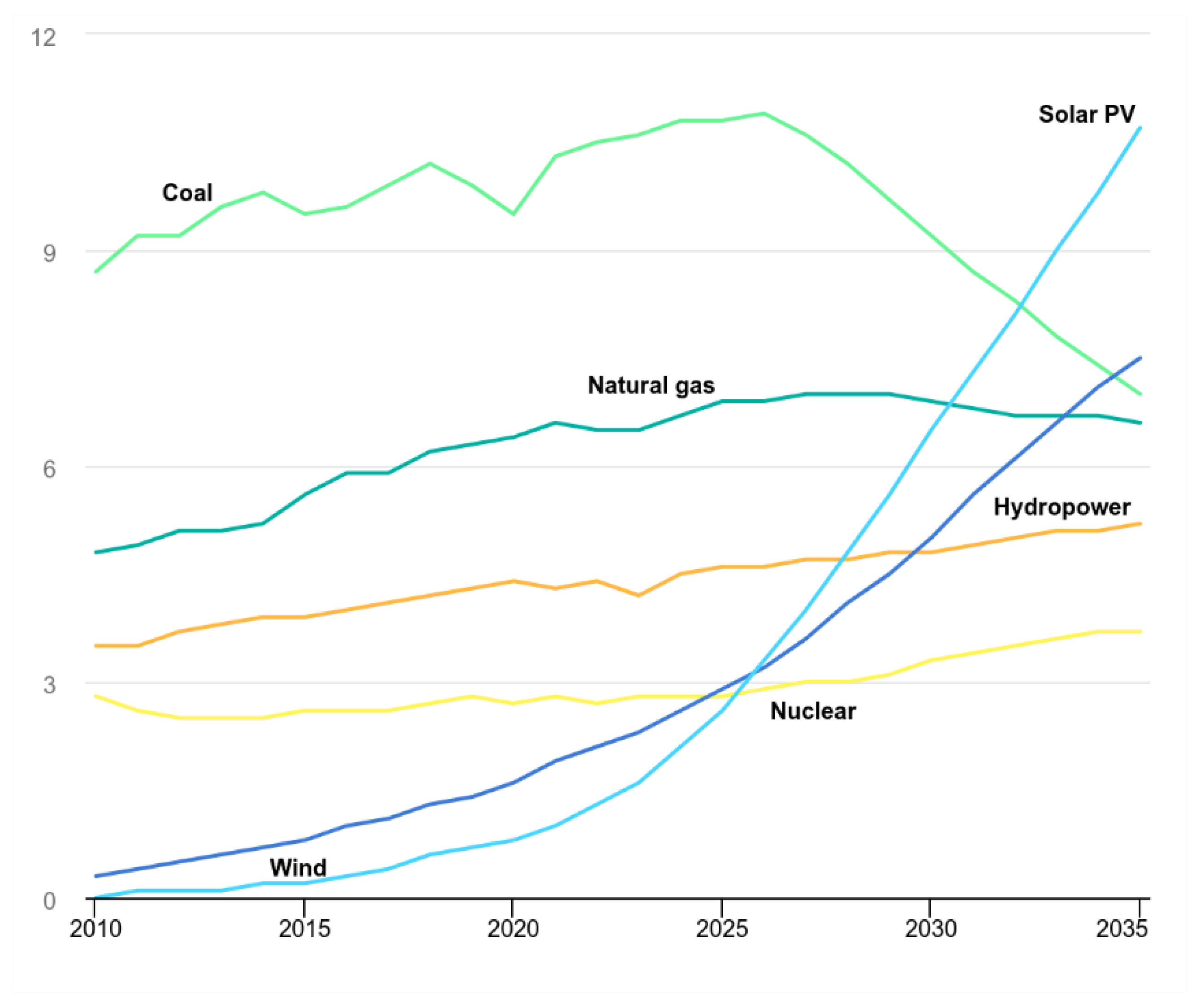
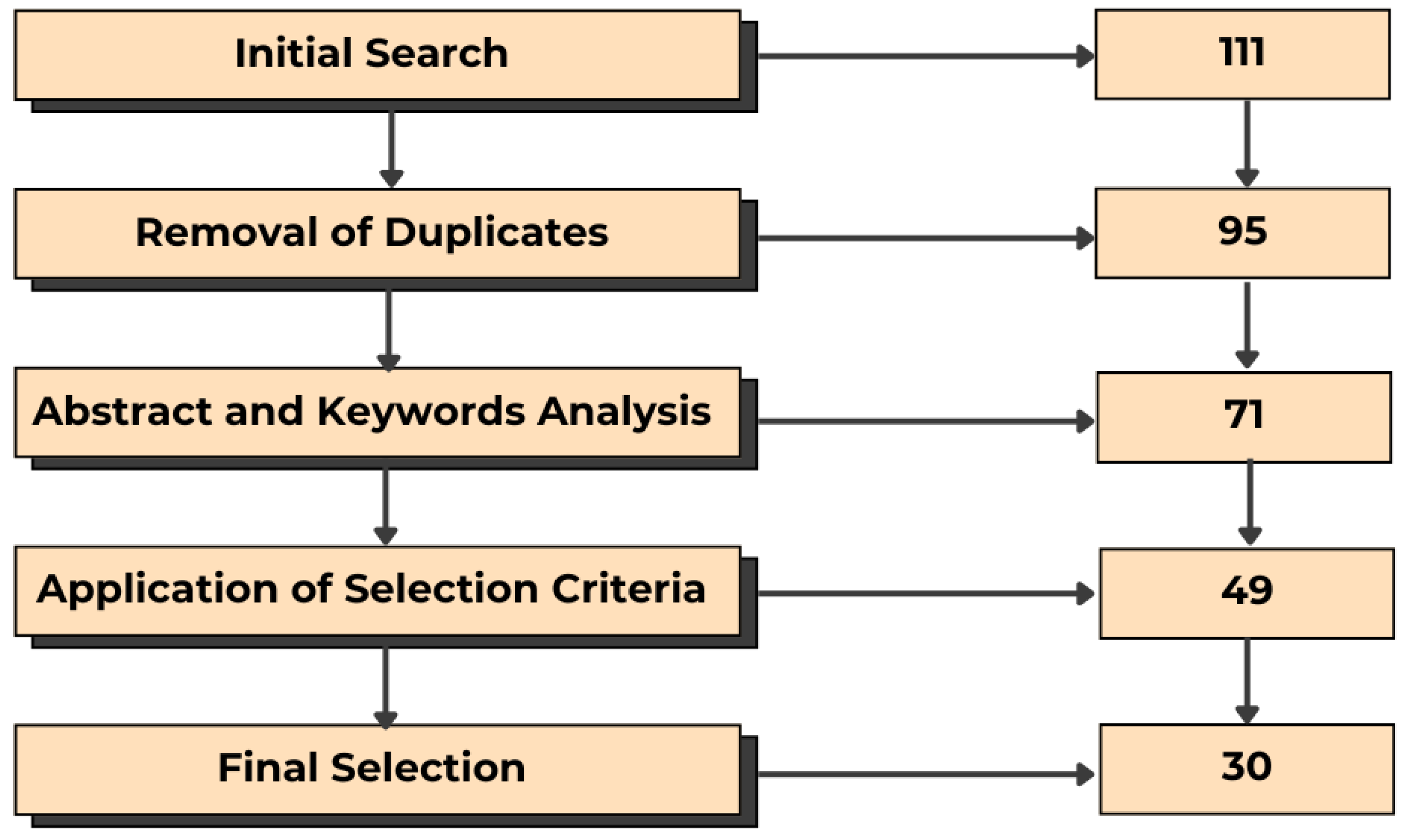
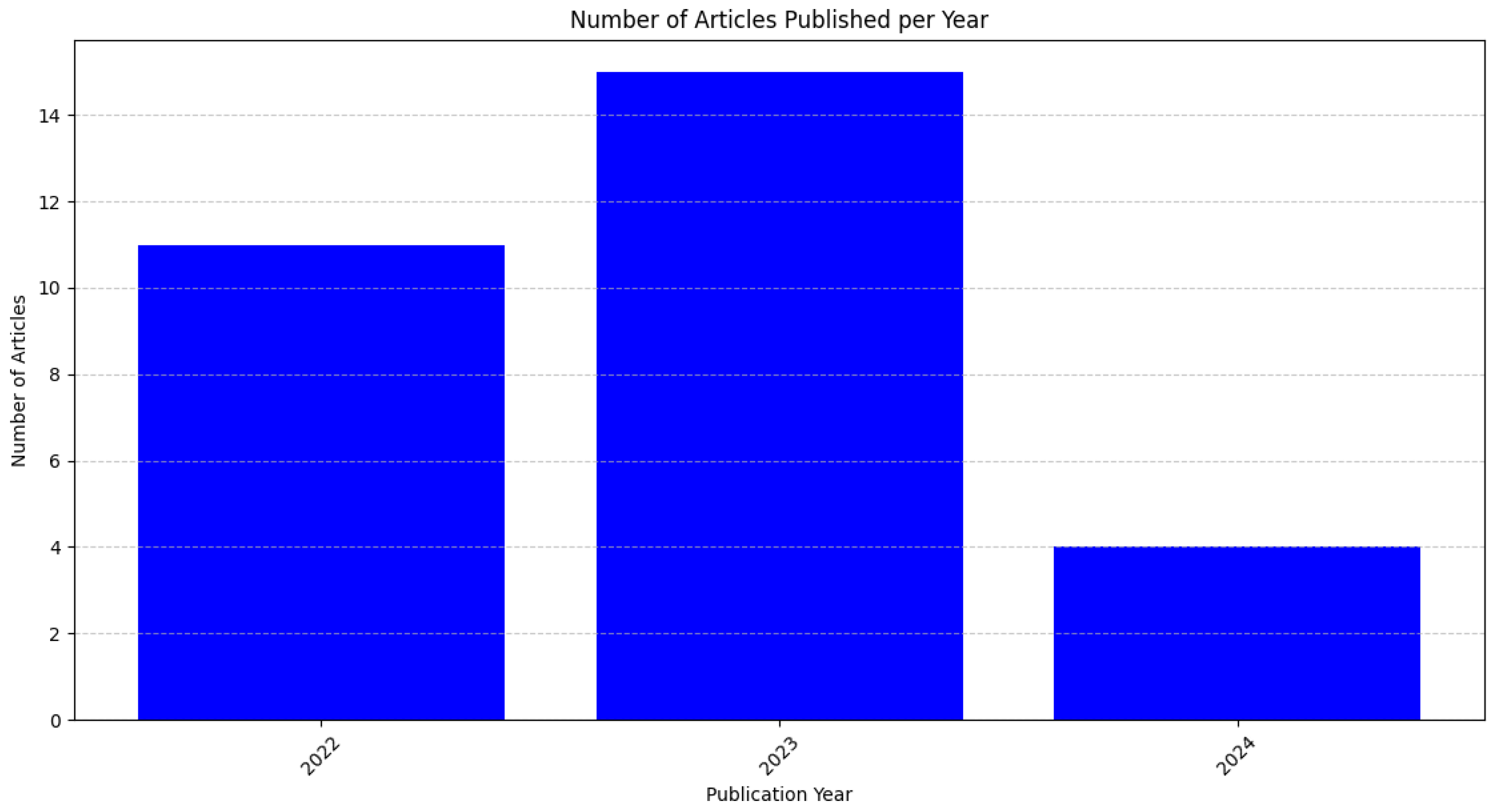
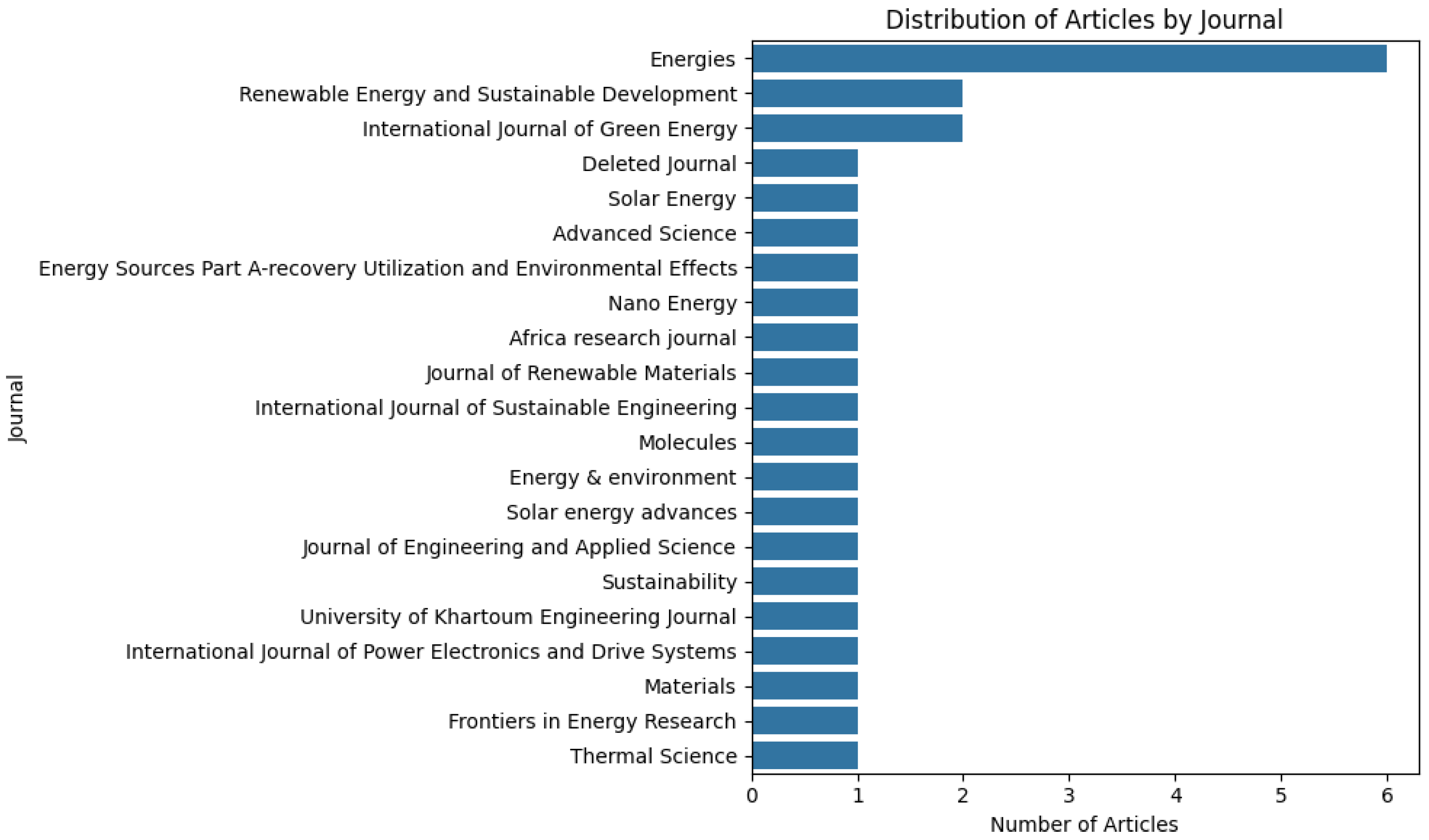
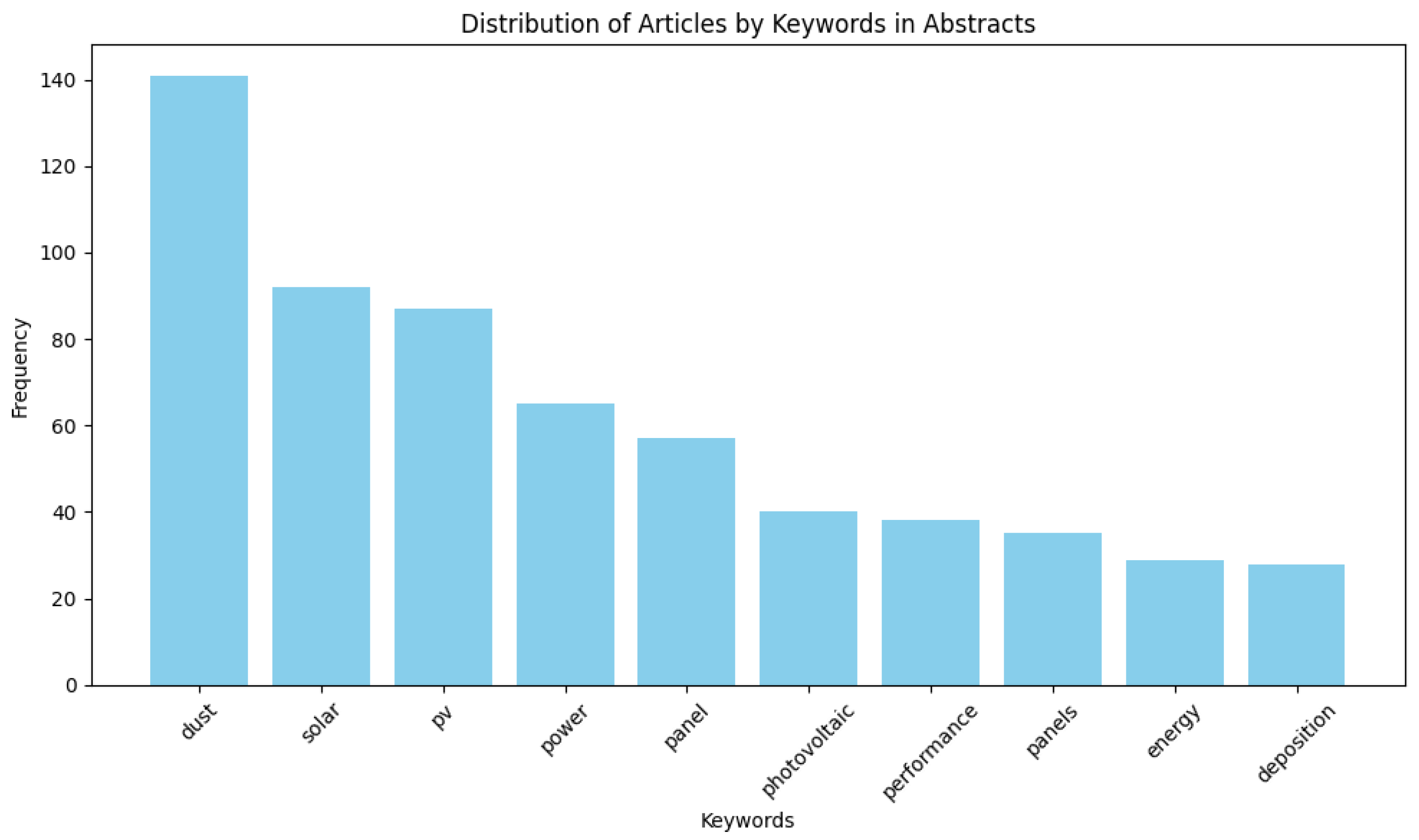
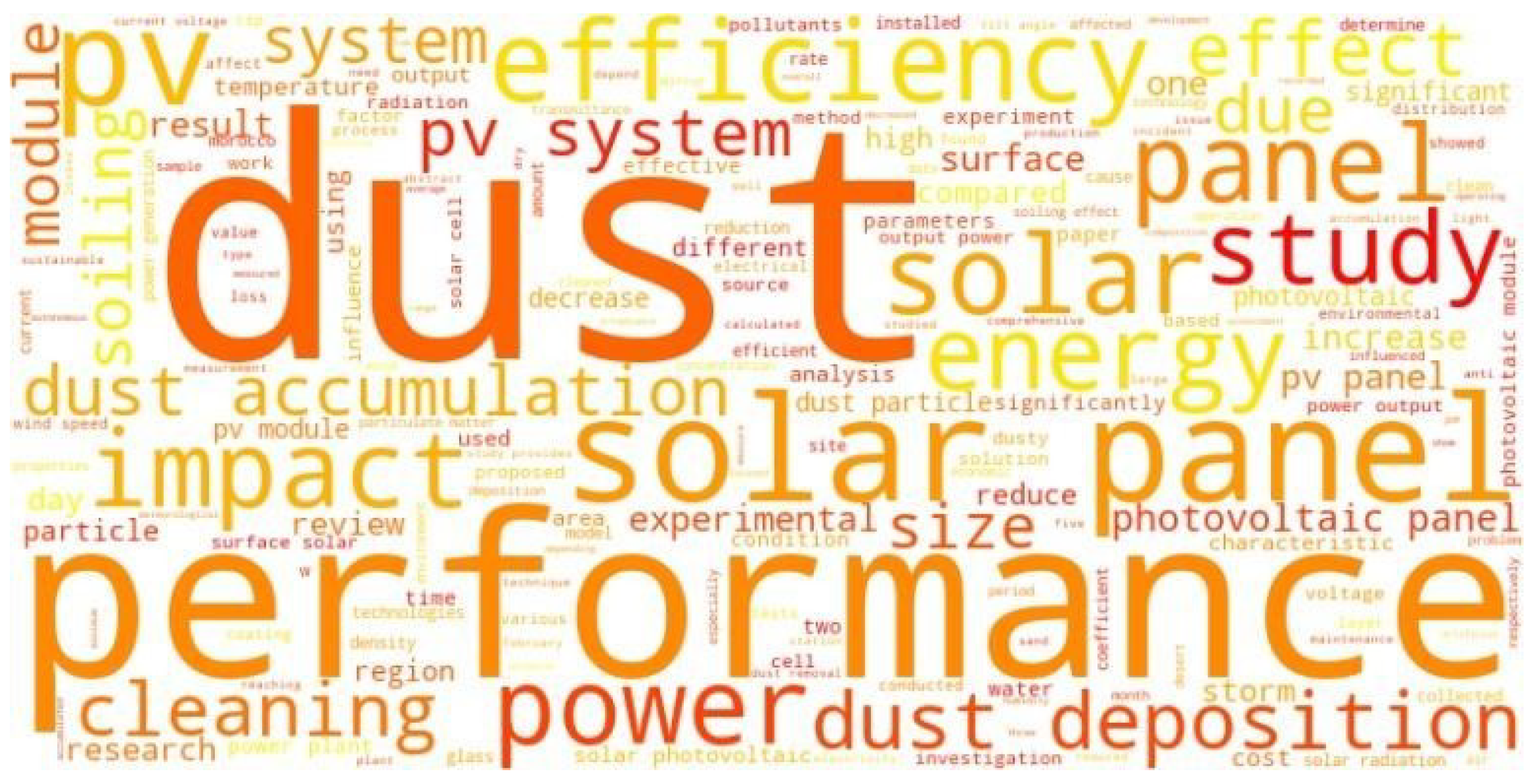
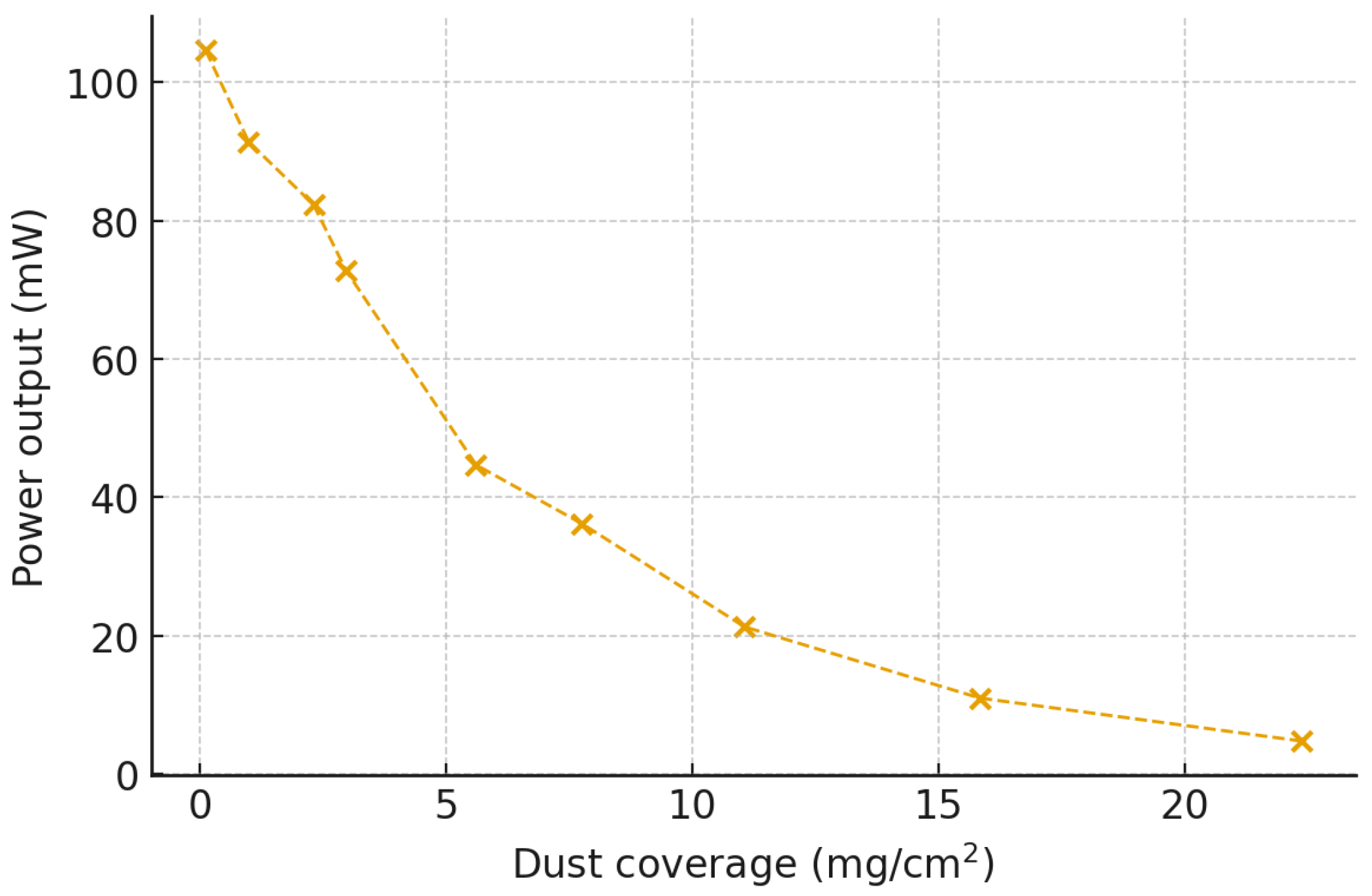
| Authors | Results | Methods Used | Objectives | Future Research |
|---|---|---|---|---|
| Toluwani mi Vincent Babalola et al. [5]. | The clean panel produced an average power of 245.04 W, compared to 183.20 W for the panel containing artificial dust. The panel containing natural dust produced 216.86 W. | The study uses three identical solar photovoltaic (PV) panels to measure key performance indicators. | The research aims to study the influence of dust accumulation on the efficiency and performance of solar photovoltaic (PV) panels. | Future research could explore the long-term effects of different types of dust (natural or artificial) on the efficiency and performance of photovoltaic solar panels. |
| Kulsoom Fatima et al. [6]. | Dust deposits on photovoltaic (PV) panels significantly hamper the penetration of solar radiation, resulting in reduced electricity generation. Cleaning PV panels every fortnight reduced power losses to 7%. | Cleaning panels every fortnight reduced power losses to 7%, balancing cleaning costs and energy efficiency. Different cleaning methodologies were analyzed to determine the most effective approach. | The study aims to analyze the consequences of dust deposition on photovoltaic systems. Another objective is to determine the optimal cleaning interval to minimize power losses caused by dust. | Research could focus on the long-term effects of different dust compositions on PV panel performance. Investigate advanced cleaning methodologies and technologies that could further reduce power losses due to dust accumulation. |
| Rongjun Ding et al. [16]. | The autonomous dust removal system effectively cleans solar panels covered with sand dust in just 6.6 min using a 15 cm diameter rotating electret generator. The system operates effectively in a wide range of environmental conditions without affecting the long-term performance of the solar panels. | The self-contained dust removal system uses a wind-driven rotating electret generator to create a high-voltage electrostatic field. This field charges dust particles on the insulating glass cover of the panel, allowing them to be repelled. | Research aims to develop an autonomous dust removal system for solar panels. A wind-driven rotating electret generator is used to solve the problem of dust accumulation. | Investigate the long-term durability and maintenance requirements of the autonomous dust collection system. Explore the scalability of wind-driven rotating electret generator technology for large solar panel installations. |
| Carmen Otilia Rusanesc u et al. [8]. | Dust accumulation on the surface of PV panels significantly reduces their efficiency, especially when solar radiation, wind speed, and relative humidity values are high. The importance of PV panel tilt angles in influencing the dust deposition rate. | The study investigated various factors affecting dust accumulation, including atmospheric temperature, solar radiation, wind speed, and relative humidity. Panel tilt angles were analyzed to determine optimal configurations to minimize dust-related efficiency losses. | The study looks at the effect of dust accumulation on the surface of photovoltaic modules. It examines the correlation between tilt angles, solar radiation, wind speed, and relative humidity. | Future research could focus on developing more efficient cleaning methods for PV panels. This could involve exploring automated cleaning systems or environmentally friendly cleaning solutions. Another area of study could be optimizing the tilt angles of PV panels under various environmental conditions. |
| Zakaria Haddad et al. [12]. | The accumulation of dust on the surface of photovoltaic solar panels significantly reduces the passage of solar radiation. The presence of dust also causes an increase in the temperature of the panels, which contributes to a reduction in energy production. | First tests to be carried out during the month of March 2022. Second test in outdoor conditions in M’sila for two months. | The research aims to experimentally study the effect of dust accumulation on the operation of photovoltaic solar panels. | Investigate the long-term effects of different types of dust on the efficiency and performance of various solar photovoltaic panel technologies. Explore the effectiveness of various methods and frequencies for cleaning solar PV panels in dusty environments. |
| Hussein A. Kazem et al. [9]. | Dust accumulation on photovoltaic (PV) modules can result in a significant reduction in power output. Studies indicate a 42–45% reduction at a dust concentration of 50 g/m2. Potential monthly efficiency losses of up to 80% if not cleaned regularly. | Dust accumulation has become a major problem in arid and semi-arid regions due to the high cost of manual cleaning. Studies on the physical properties of dust, such as shape, size, and homogeneity, were conducted using X-ray diffraction (XRD) and microscopic analysis. | The paper aims to review and discuss the effects of dust accumulation on photovoltaic (PV) modules, including its impact on glass and transparent materials, mirrors, and the overall performance of PV systems. | Future research should focus on the development and standardization of automated cleaning systems for photovoltaic modules. This includes investigating the effectiveness and cost-effectiveness of various cleaning technologies to mitigate the impact of dust on PV performance. |
| Min Geun Heo et al. [10]. | The study achieved efficiencies of over 90% in solar panel performance at wind speeds of 28 m/s. The research highlights the successful optimization of the RTENG structure, electrode design, and EDS plate dielectric material. | Wind-driven rotating triboelectric nanogenerators (RTENGs) to autonomously power electrodynamic screen (EDS) systems for dust removal. | Research aims to develop an autonomous electrodynamic screen (EDS) system for autonomous dust removal of solar panels. Wind-driven rotating triboelectric nanogenerators (RTENGs) as a sustainable energy source. | Future research could explore the optimization of triboelectric nanogenerator (TENG) designs to improve the power output at different wind speeds. |
| Naseem Ahmad et al. [17]. | The study found that the performance of photovoltaic (PV) solar cells is negatively affected by the amount of dust on their surface. Tests conducted at different humidity levels (30% to 65%) demonstrated significant changes in efficiency. | Experiments were conducted on different types of dust (sand, soil, and ash) to assess their effects on the output performance of solar photovoltaic (PV) cells. The study also tested the impact of relative humidity on the performance of the PV cells. | Research aims to identify and analyze environmental parameters, particularly dust and humidity, that adversely affect the performance and efficiency of photovoltaic (PV) solar cells. | Future research could focus on developing advanced cleaning technologies or coatings for photovoltaic (PV) solar cells. |
| Maison Hussein Omar et al. [4]. | The proposed AI-powered wind turbine-driven air–water harvester can produce more than two liters of water per day while consuming a maximum of 100 W of energy. It could be used to clean PV panels in remote and water-stressed areas. | The air–water recuperator is powered by a wind turbine and equipped with artificial intelligence. It operates in three different modes depending on the amount of dust on the surface of the solar panel. The system is designed to efficiently produce water to clean the panels. | The air–water recuperator is powered by a wind turbine and activated by artificial intelligence. The system is designed to operate in three different modes depending on the dust levels on the surface of the solar panel. | Future research could focus on optimizing the artificial intelligence algorithms used in the air–water collector to improve its efficiency. |
| Abdellah Asbayou et al. [2]. | The optical transmittance of the front glass of the PV panel is significantly influenced by the nature and density of the dust. The reduction in particle size leads to a greater reduction in light transmission and, consequently, in the efficiency of the solar panels. | The study used scanning electron microscopy and energy-dispersive X-ray spectroscopy to analyze dust collected at two sites in Agadir, Morocco. Experiments were conducted to assess the effects of soiling on the performance of a photovoltaic panel. | The research aims to study the effects of dust fouling on the performance of photovoltaic (PV) panels by analyzing dust collected from two different sites in Agadir, Morocco. | Future research could focus on the long-term effects of different types of dust on solar panel efficiency. Studying the effectiveness of different solar panel cleaning methods could provide insights into optimizing maintenance practices. |
| Hussam M. Almukhta r et al. [1]. | The paper highlights the significant impact of dust characteristics on the performance of photovoltaic (PV) systems. It highlights the need for further research on dust properties such as thermal conductivity and emissivity. | The free-falling dust method is a typical approach to quantify the influence of dust deposition on photovoltaic performance. A solar simulator is a device that creates a regulated light source to simulate the sun for indoor research. | The paper aims to provide a comprehensive review of the existing literature on the impact of dust characteristics on photovoltaic (PV) systems. This analysis aims to better understand how dust accumulation affects PV performance. | Further research is needed to study the impact of different types and amounts of dust on photovoltaic (PV) systems. This includes developing different parameters to accurately predict the transmission reduction for different types of dust. |
| Haneen Abuzaid et al. [18]. | The study highlights the significant negative impact of dust accumulation on PV panel performance, particularly in hot and arid regions. The study identifies research gaps, including the need for dynamic optimization models. | The study reviews various PV panel cleaning techniques and programs. It highlights the importance of modeling dust accumulation along with other environmental factors such as temperature, humidity, and wind speed. | The study aims to provide a comprehensive review of the impact of dust accumulation on the performance of photovoltaic (PV) panels. | There is a need for appropriate dynamic optimization models for cleaning schedules. Further research is needed to develop more advanced machine and deep learning models. |
| Gowtham Vedulla et al. [19]. | Dust accumulation on photovoltaic (PV) solar panels significantly reduces their efficiency by obstructing solar radiation. The study highlights the need to study dust characteristics, such as the type, size, and shape, in order to develop effective solutions to maintain optimal PV performance. | The paper discusses the use of a robotic arm system to efficiently clean the surface of the photovoltaic module. Different self-cleaning coatings on the cover glass of solar cells were experimentally explored. | The paper aims to study the characteristics of dust accumulation on solar photovoltaic (PV) panels. It aims to develop specific solutions to efficiently harness solar energy. | Discovery of specific characteristics of dust particles, including their type, size and shape, as well as the impact of weather elements on the performance of solar photovoltaic (PV) systems. |
| Abhishek Tripathi et al. [20]. | The zero-resistance current of the solar photovoltaic (PV) panel decreased by up to 49.01% due to the presence of small dust particles. In addition, there was a significant reduction of nearly 40% in the penetration of sunlight on the surface of the PV panels | The research was conducted with a test device designed to inspect the behavior of the PV panel when covered with dust particles. The experimental setup included a 1 m high stand with a flat edge to hold the panel horizontally and a 20 W polycrystalline PV solar panel mounted on a flat frame | The study aims to use experimental and machine learning approaches to predict the power output of solar photovoltaic panels. | Future research could focus on analyzing the frequency of dust cleaning from solar photovoltaic (PV) panel surfaces. This would help determine optimal cleaning schedules to maintain panel efficiency. |
| Saman Sarkawt Jaafar et al. [21]. | A non-uniform distribution of pollutant dust can lead to a significant reduction in output power. Increasing the tilt angle of the PV panel can improve the output power, effectively doubling it, except in the case of toner dust. | The experimental setup involved a single photovoltaic (PV) panel producing 15 W of energy. Five different dust samples (toner, soil, cement, gypsum, and sand) were applied to evaluate their impact on the output power. | Research aims to quantitatively determine the impact of dust deposition on the power generation efficiency of photovoltaic (PV) panels. The study aims to investigate the relationship between the non-uniform distribution of pollutant dust and the resulting power reduction. | Future research should focus on developing a model that accounts for the non-uniform distribution of dust pollutants on PV panels. This would improve the accuracy of the experimental results and provide a better understanding of the different extinction coefficients at different points on the PV panel. |
| Rajni Saini et al. [22]. | Dust has a significant impact on the performance of solar panels, especially in hot and dusty areas. Modern cleaning techniques for photovoltaic modules can improve efficiency. | The authors recommend the adoption of a modern cleaning technique for photovoltaic (PV) modules. The technique can be used outside the PV modules, thus improving maintenance efficiency. | The main objective of the review article is to assess the impact of dust particles on the performance of solar panels, especially in hot and dusty environments. The article aims to update the contributions of researchers from 2015 to 2020 regarding the effects of dust. | Future research could focus on developing and optimizing modern cleaning techniques for photovoltaic modules. Studying the long-term effects of different types of dust particles on solar panel performance in different geographical areas could provide valuable information. |
| Mounir Abraim et al. [23]. | The soiling effect on concentrated solar power (CSP) mirrors results in an annual average soiling rate of −1.18% per day. The efficiency loss due to soiling is more pronounced during extreme weather events, such as red rains. | The study used real-time soiling sensors to measure the effect of soiling on concentrated solar power (CSP) and photovoltaic (PV) technologies. A well-described methodology was developed to process the raw data collected. | The study aims to perform a simultaneous and long-term comparative analysis of the effect of soiling on concentrated solar power and photovoltaic technologies. | Research on the long-term effects of extreme weather events, such as dust storms and heavy rainfall, on the efficiency of CSP and PV technologies. Exploration of advanced cleaning techniques and technologies that can mitigate the effects of soiling on solar collectors. |
| Reham Kamal et al. [24]. | Dust accumulation on a PV module resulted in a significant decrease in incident solar radiation. A reduction of 68% of the initial radiation due to dust, resulting in a 31% decrease in the maximum output power. | Computer code to model the propagation of incident solar radiation through the layers of a dusty photovoltaic module. This method involves calculating the reflectance and transmittance at the interfaces between these layers. | The paper aims to evaluate the current–voltage and supply voltage characteristics of a photovoltaic (PV) module influenced by dust accumulation. | Future research could focus on developing more advanced models that incorporate a wider range of environmental factors. This could lead to the design of self-cleaning surfaces or coatings that minimize dust accumulation. |
| István Bodnár et al. [25]. | Research on a 10,044 MWp solar power plant with operational problems revealed that pollution from nearby industrial and conventional power plants leads to surface dirt deposits on the solar panels. | The paper used on-site thermal imaging of the solar power plant to assess the condition of the panels. This method identified thermal anomalies that could indicate overheating or inefficiency. | The solar power plant is to be inspected to identify the cause of operational issues. Investigate the impact of pollution from industrial and conventional power plants on the performance of solar panels. | Future research should focus on conducting new laboratory thermal imaging studies. This will help develop more effective maintenance strategies to mitigate the impact of contamination and operational issues. |
| Shing-Lih Wu et al. [26]. | Wind speed significantly affects dust deposition on solar panels. Wind speeds above 5 m/s effectively reduce the number of dust particles on the surface. In contrast, wind speeds of 1 and 3m/s had no significant impact on dust accumulation. | The paper used the discrete element method (DEM) to establish a mechanical model of contact between dust particles and the surface of solar panels. The model considered a uniform distribution of spherical dust particles of random sizes. | The main objective of the research is to analyze the distribution of dust on the surface of solar panels over time. | Future research could focus on implementing automated measurement techniques to accurately represent the transmittance of solar panels, thereby improving the understanding of how dust accumulation affects their efficiency. |
| Abubaker Younis et al. [27]. | The study demonstrates the impact of dust accumulation on the performance of photovoltaic (PV) modules. It highlights the negative effects of dirt on energy production. | A short-circuit current dust coefficient was developed to represent the effect of dirt under predefined environmental conditions and varying amounts of dust. | The study aims to develop an empirical coefficient, called the short-circuit current dust coefficient, which will quantify the impact of dirt on photovoltaic performance. | – |
| Arjyadhara Pradhan et al. [28]. | The performance of photovoltaic (PV) panels deteriorates significantly with increasing dust deposition. The results indicated that dusty panels produced lower output voltage and current than clean panels. | A real-time experiment was conducted using two PV modules: one in a clean state and the other in a dusty state. The study calculated three main parameters for each external factor affecting PV modules: the maximum power, module efficiency, and fill factor. | Research aims to analyze the impact of dust deposition on the performance of photovoltaic panels. The study also aims to design an efficient solar dust cleaning and cooling system. | Future research could focus on developing more advanced automated cleaning systems for PV panels. This could include exploring the use of ionic surfactants or automated sprayers. |
| Mohammad Istiaque Hossain et al. [29]. | Dust accumulation can reach 1% per day in the Middle East and North Africa. Dust-control coatings could be a better alternative to mechanical cleaning. | The paper discusses the development and application of soil-repellent coatings for photovoltaic (PV) panels in desert environments. The paper reviews various techniques and materials to mitigate soiling problems of PV panels. | The paper aims to critically review the different anti-fouling technologies used to mitigate the problem of photovoltaic panel fouling. The effectiveness of different coatings and their suitability depend on climatic conditions and geographical location, particularly in desert environments such as the MENA region | There is a need to develop multifunctional coatings that combine antifouling and antireflective properties, as current market offerings are limited. Research should focus on creating highly transparent, durable, non-toxic coatings with self-cleaning characteristics. |
| Muhammad Tamoor et al. [30]. | The study found that the concentration of airborne particles (PM 10 and PM 2.5) exceeded the permissible limits at all selected sites in the Sargodha region. The accumulation of particulate matter layers on the surface of the PV module resulted in reduced power generation. | Two photovoltaic systems were installed at a site with a higher particulate concentration. One system was cleaned regularly, while the other remained dusty. The performance of both systems was measured over a period of four months. | The main objective of the study is to investigate the impact of airborne particles (PM 10 and PM 2.5) on the performance of photovoltaic systems in the Sargodha region. Research aims to analyze the concentration, chemical composition, and accumulation of particles. | Future research could focus on the long-term effects of different levels of airborne particles (PM 10 and PM 2.5) on the performance and longevity of PV systems. |
| Miqdam T. Chaichan et al. [31]. | Solar radiation intensity decreased by 54.5%, and air temperature dropped by 21.09%. There was a significant increase in ultrafine aerosol particles. Practical measurements indicated a deterioration in the performance of photovoltaic modules. | A comprehensive study of wind movement and its sources affecting Baghdad was conducted. Practical experiments were conducted during a severe dust storm from April 1 to 12, 2022. | The study aims to conduct a comprehensive examination of wind motion and its sources. It aims to empirically study the impact of dust storms on solar radiation intensity and photovoltaic module performance. | Future research could focus on developing more effective cleaning methods for PV modules during and after dust storms. Investigating alternative cleaning technologies or materials that can minimize dust accumulation could improve the efficiency of solar energy systems. |
| Gowtham Vedulla et al. [19]. | Cement caused a power loss of 0.067%, while brick, white cement, fly ash, and coal caused power losses of 0.190%, 0.163%, 0.164%, and 0.177%, respectively. A higher tilt angle minimizes dust retention and maximizes the irradiance incident on the panel. | An experimental system was set up with a photovoltaic module placed under artificial illumination from 16 electric lamps. The experiment consisted of spreading dust particles with a constant weight of 10 g and different irradiance values on a flour sieve. | The study aims to study the impact of different types of dust particles on the power loss and efficiency reduction of solar photovoltaic (PV) panels. | Future research should focus on analyzing the performance of solar photovoltaic (PV) panels in outdoor environments. Studying the chemical composition of different outdoor dust particles will provide a better understanding of how these variations influence the power loss and efficiency reduction. |
| Zhaohui Zhang et al. [32]. | The study established that the composition and size of dust particles deposited on the photovoltaic modules were constant in different areas. The proposed monitoring model for dust deposition achieved an accuracy of 94% in reflecting the degree of dust accumulation. | The solar photovoltaic power plant is in the Kubuqi Desert. Analysis of the composition and size characteristics of dust collected by a solar photvoltaic plant. Establishing relationships between dust density and solar cell output parameters. | The research aims to accurately assess the characteristics of dust deposition on photovoltaic modules in order to improve power generation forecasts and establish effective cleaning cycles. | Future research could focus on the long-term effects of dust composition and particle size on the efficiency of solar PV modules. |
| Benyouness Raillani et al. [33]. | The dirt rate can reduce monthly electricity production by an average of 14.08% for solar tower (ST) technology and 15.615% for linear Fresnel reflector (LFR) technology. ST technology has better technical and economic performance compared to LFR technology. | The paper uses experimental methods to study the cleanliness of a square mirror in the climatic conditions of eastern Morocco. It uses numerical simulations to analyze the experimental results. | Research aims to experimentally study the cleanliness of a square mirror in the climatic conditions of eastern Morocco. The study aims to use the experimental results in simulations to assess energy losses in large solar power plants. | Future research could focus on developing more efficient cleaning methods or technologies for solar mirrors to minimize optical losses through fouling. A future study could include a comprehensive analysis of the long-term economic impacts of fouling on different solar technologies. |
| Mahdi Sarhan et al. [34]. | The study analyzes the effect of dust on solar panel efficiency by comparing clean and dusty panels. An automated water cleaning system was developed to improve performance and maintain efficiency cost-effectively. | An automated closed-loop water system was designed and implemented to clean solar panels, improving their efficiency by removing dust accumulation. The study compared the performance of two solar panels, one clean and one dusty, to analyze the effect of dust on solar cell efficiency. | The primary objective of the research is to study the impact of dust on solar cell performance and efficiency by comparing clean and dusty solar panels, each with 12 cells. Another goal is to design and implement a cost-effective automated closed-loop water system to clean the panels, enhancing efficiency and addressing the challenge of maintaining high and stable performance in solar energy systems. | Future research may focus on cost-effective solar cell development and exploring alternative cleaning systems or materials to reduce dust accumulation, improving panel performance and longevity. |
Disclaimer/Publisher’s Note: The statements, opinions and data contained in all publications are solely those of the individual author(s) and contributor(s) and not of MDPI and/or the editor(s). MDPI and/or the editor(s) disclaim responsibility for any injury to people or property resulting from any ideas, methods, instructions or products referred to in the content. |
© 2025 by the authors. Licensee MDPI, Basel, Switzerland. This article is an open access article distributed under the terms and conditions of the Creative Commons Attribution (CC BY) license (https://creativecommons.org/licenses/by/4.0/).
Share and Cite
Abdessadak, A.; Ghennioui, H.; El Bhiri, B.; Thirion-Moreau, N.; Abraim, M.; Merzouk, S. Assessing the Effects of Dust on Solar Panel Performance: A Comprehensive Review and Future Directions. Eng. Proc. 2025, 112, 9. https://doi.org/10.3390/engproc2025112009
Abdessadak A, Ghennioui H, El Bhiri B, Thirion-Moreau N, Abraim M, Merzouk S. Assessing the Effects of Dust on Solar Panel Performance: A Comprehensive Review and Future Directions. Engineering Proceedings. 2025; 112(1):9. https://doi.org/10.3390/engproc2025112009
Chicago/Turabian StyleAbdessadak, Abdelali, Hicham Ghennioui, Brahim El Bhiri, Nadège Thirion-Moreau, Mounir Abraim, and Safae Merzouk. 2025. "Assessing the Effects of Dust on Solar Panel Performance: A Comprehensive Review and Future Directions" Engineering Proceedings 112, no. 1: 9. https://doi.org/10.3390/engproc2025112009
APA StyleAbdessadak, A., Ghennioui, H., El Bhiri, B., Thirion-Moreau, N., Abraim, M., & Merzouk, S. (2025). Assessing the Effects of Dust on Solar Panel Performance: A Comprehensive Review and Future Directions. Engineering Proceedings, 112(1), 9. https://doi.org/10.3390/engproc2025112009






